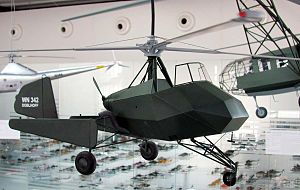Doblhoff WNF 342
| Doblhoff/WNF 342 | |
|---|---|
 |
|
| Doblhoff WNF 342 V4 model in the Hubschraubermuseum Bückeburg (Bückeburg Helicopter Museum) | |
| Role | Tip jet research helicopter |
| National origin | Austria |
| Manufacturer | Wiener-Neustädter Flugzeugwerke |
| Designer | Friedrich von Doblhoff |
| First flight | 1943 |
| Number built | 3 |
The Doblhoff/WNF 342 was the first helicopter to take off and land using Tip jets to drive the rotor.
The WNF 342 was designed for a German Navy requirement for an observation platform for use from small ships and submarines.
The conventional piston engine drove both a small propeller (to provide airflow across a rudder) and an air compressor to provide air (subsequently mixed with fuel) through the rotor head and hollow rotor blades to combustion chambers at the rotor tips. As a research helicopter it was a simple design to allow modification.
V1/V2: The first helicopter was initially powered by a 60 horsepower (45 kW) engine (V1) and then a 90 horsepower (67 kW) engine (V2)—both by Walter Mikron. It first flew in 1943, and was captured with V4 at Zell am See.
V3: The second WNF 342 had a larger rotor and was destroyed during testing.
V4: The last unit produced was a two-seat variant with new collective and cyclic controls. After 25 flight hours it was captured by United States forces and on July 19, 1945, shipped to the US under Operation Lusty on the HMS Reaper (D82).[1]
Data from Illustrated Encyclopedia of Aircraft
General characteristics
Performance
...
Wikipedia
